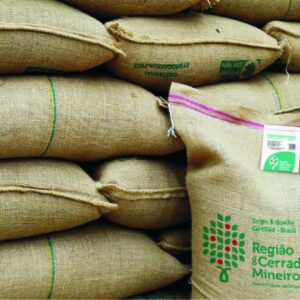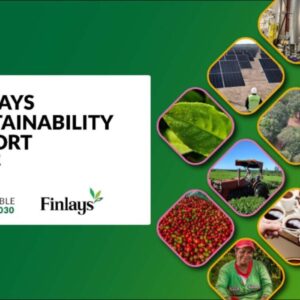Coffee prices plummeted in June following the USDA’s report of another CY bag surplus

Image: Nescafe
In its June green coffee report, the International Coffee Organization (ICO) announced sharp coffee price declines on the heels of a larger coffee bag surplus for coffee year 2025/26 than in CY 2024/25. The ICO Composite Indicator Price (I-CIP) averaged 295.06 US cents/lb in June 2025, an 11.8% decrease from May 2025. This is the first time since December 2024 that the I-CIP has fallen below the 300 US cents/lb mark. The I-CIP posted a median value of 303.02 US cents/lb and fluctuated between 267.02 and 317.41 US cents/lb. The I-CIP followed a downward trend throughout the month of June. The June 2025 I-CIP is above the June 2024 I-CIP by 30.1%, with the 12-month rolling average at 294.39 US cents/lb.
The Colombian Milds’ and Other Milds’ prices both decreased by 9.0% and 8.7% compared to May 2025, averaging 360.08 and 363.16 US cents/lb, respectively, in June 2025. The Brazilian Naturals also fell 10.9% to 338.53 US cents/lb in June 2025. The Robustas retracted the most, down 17.5% to 196.21 US cents/lb. This is the first since January 2024 that the Robustas price has fallen below the 200.0 US cents/lb mark. The prices at the London Intercontinental Commodity Exchange (ICE) market decreased by 18.4% to 183.21 US cents/lb, while the New York ICE market shrank by 10.5% to 329.56 US cents/lb in June 2025.
Supply was the main factor behind the I-CIP’s retreat in May 2025, and it remains at the center of the continued retreat in June 2025. On 2 June 2025, the United States Department of Agriculture released its semi-annual report on the world coffee balance, which estimated a 9.32-million-bag surplus for coffee year 2025/26, following a 7.88-million-bag surplus in coffee year 2024/25. In addition, the certified stocks held by the ICE increased to a nine-month high of 1.85 million bags at the end of May, contributing to the negative market sentiment, before then falling to 1.78 million bags by the end of June.
The I-CIP sharply recovered on 23 June on the back of news of frost in the main coffee-growing regions of Brazil, São Paulo and Minas Gerais. The I-CIP jumped by 3.6% to 288.8 US cents/lb from 278.75 US cents/lb on 20 June. However, the rally was short-lived, due to subsequent weather reports that abated the risks of frost in São Paulo and Minas Gerais. The Colombian Milds–Other Milds differential shrank further from -2.25 to -3.08 US cents/lb between May 2025 and June 2025.
The Colombian Milds–Brazilian Naturals differential widened by 38.4% to 21.55 US cents/lb, whilst the Colombian Milds–Robustas differential grew by 3.8% from May 2025 to June 2025, averaging 163.86 US cents/lb. Meanwhile, the Other Milds–Brazilian Naturals and Other Milds–Robustas differentials moved by 38.2% and 4.3% to 24.63 and 166.95 US cents/lb, respectively. The Brazilian Naturals–Robustas differential expanded by 0.04%, averaging 142.32 US cents/lb in June 2025.
The arbitrage, as measured between the London and New York futures markets, grew further by 1.9% to 146.35 US cents/lb in June 2025.
The intra-day volatility of the I-CIP declined by 0.9 percentage points compared to May 2025, averaging 10.2% in June 2025. The volatility of the Colombian Milds, Other Milds and Brazilian Naturals oscillated by 1.2, 1.0 and 0.6 percentage points, month-on-month, to 10.1%, 10.2% and 12.2%, respectively, in June 2025. The Robustas’ volatility decreased to 10.2% from 11.5% in May 2025. At the New York and London futures markets, the volatilities were at 10.6% and 10.3%, respectively, in June 2025, down by 1.8 and 1.2 percentage points compared to May 2025.
The London certified stocks of Robusta coffee decreased by 4.9% from May 2025 to June 2025, closing the month at 0.87 million bags. Certified stocks of Arabica coffee followed the same trend, shrinking to 0.91 million 60-kg bags, a 2.6% decrease versus May 2025.
Exports by Coffee Groups – Green Beans
In May 2025, global green bean exports totalled 11.2 million bags, as compared with 10.82 million bags in May 2024, up 3.5%. The latest downturn was mainly driven by the Robustas. As a result, the year-to-date volume for total green bean exports is down 3.1% at 81.97 million bags, as compared with 84.61 million bags between October 2023 and May 2024.
Exports of the Colombian Milds decreased by 3.0% in May 2025 to 0.96 million bags from 0.98 million bags in May 2024. This is the first negative growth following nineteen consecutive months of positive growth for this group of coffee, and as a result the year-to-date volume is up 15.5% at 9.35 million bags, as compared with 8.09 million bags between October 2023 and May 2024. The main source of the negative contribution was Colombia, whose exports decreased by 3.6% to 0.82 million bags in May 2025 from 0.85 million bags in May 2024. This marks the second downturn after 17 consecutive months of upturn for Colombia. The turnaround of the country’s exports trend appears to be a natural reaction to the bumper crop observed in calendar year 2024, when exports increased by 17.0% to 11.38 million bags, with a net gain of 1.65 million bags over calendar year 2023.
Shipments of the Other Milds were up 4.2% in May 2025 to 2.65 million bags from 2.54 million bags in the same period in 2024. The main positive contributions came from Ethiopia and Nicaragua, up 40.9% and 66.0%, with net gains of 0.09 million bags and 0.16 million bags. The relatively subdued growth rate of the group was due to the partially-counterbalancing 56.9% drop in exports from Mexico, with a net loss of 0.1 million bags.
Green bean exports of the Brazilian Naturals decreased by 11.2% in May 2025 to 3.29 million bags from 3.71 million bags in May 2024. Brazil was the main driver of the downturn, with its exports decreasing by 22.5% to 2.37 million bags from 3.06 million bags in May 2024. The negative growth was once again due to the base effect and the strong cyclical nature of Brazil’s Arabica coffee. Coffee year 2023/24 was an “on-year” for Brazil’s exports of the Brazilian Naturals, up 21.7% for the year and up 40.8% in May 2024 versus May 2023. Ethiopia was the main mitigating factor, softening the full negative impact of Brazil’s fall with a 42.6% increase in exports, shipping 0.67 million bags versus 0.47 million bags in May 2024. The double digit increase continues to appear to be a result of the combined impact of front-loading new supply from the coffee year 2024/25 harvest and the continued release of stocks in higher volume, as Ethiopia takes advantage of the elevated level of international coffee prices.
Green bean exports of the Robustas were up 20.1% to 4.31 million bags in May 2025 from 3.59 million bags in May 2024. The main driver of the positive growth was Vietnam, whose exports increased by 87.3% to 2.36 million bags in May 2025, with a net gain of 1.1 million bags. Indonesia and Uganda were the other positive forces behind the Robustas’ double-digit growth rate in May 2025, with their exports up 381.6% and 45.9%, resulting in net gains of 0.38 million bags and 0.22 million bags, respectively. Counter-balancing this, to an extent, was Brazil, whose exports decreased by 79.1% to 0.2 million bags in May 2025 from 0.97 million bags in May 2024. Brazil’s sharp downturn reflects the origin’s exports returning to relative normality after prolonged, unusually elevated levels of exports for the period between July 2023 and October 2024, during which 12.27 million bags of Robustas were exported, as well as during coffee year 2023/24, when 9.37 million bags were exported.
The Arabicas’ share of the total green bean exports for the first eight months of coffee year 2024/25 to May 2025 increased to 62.9% from 60.8% over the same period a year ago.
Exports by Regions – All Forms of Coffee
Exports of all forms of coffee from the world as a whole increased by 4.9% to 12.65 million bags in May 2025 as compared with 12.05 million bags in May 2024. However, the year-to-date exports fell to 91.29 million bags from 93.44 million bags over the same period a year ago. Three out of four regions saw their exports expand, with only South America experiencing a downturn. May 2025 was the seventh consecutive month of downturn for South America, which pushed down the region’s share of the total exports to 32.3% in May 2025 as compared with 45.6% in May 2024.
Exports of all forms of coffee from Asia & Oceania were up 48.9% to 4.11 million bags in May 2025 from 2.76 million bags in May 2024. The expansion was driven by Vietnam, whose exports were up 87.3% to 2.54 million bags from 1.36 million bags in May 2024. The rate of growth reflects a base effect, with the May 2024 exports being the lowest May shipment since the 1.34 million bags shipped in 2009. To put the May 2024 figure into perspective, the average May shipment for 2018−2022 is 2.32 million bags. Indonesia was another notable positive contributor towards the region’s double-digit growth rate, with exports up 23.3% to 0.76 million bags. This is the seventh expansion in the first eight months of coffee year 2024/25 for Indonesia, with year-to-date exports up 53.0% to 6.06 million bags. The better-than-expected harvest for coffee year 2024/25, which has increased the exportable supply, appears to be behind the strong export performance.
Exports of all forms of coffee from Africa increased by 33.3% in May 2025 to 2.33 million bags from 1.75 million bags in May 2024. Ethiopia and Uganda were the two main drivers behind the region’s growth in May 2025, with their exports up 42.0% and 43.3% to 0.98 million bags and 0.79 million bags, respectively. For both regions, a good harvest – and hence supply – associated with high international coffee prices and front-loading appears to explain this growth. Many in the market are estimating coffee year 2024/25 to be an on-year for Ethiopia, with a net 0.5-million-bag increase in output. In Uganda, a good crop from the main harvest in the Masaka and southwestern regions was offered as an explanation by the Uganda Coffee Development Authority.
In May 2025, South America’s exports of all forms of coffee decreased by 25.7% to 4.08 million bags from 5.5 million bags in May 2024. This is the seventh consecutive month of negative growth for the region, following a 16-month streak of positive growth. The downturn was due to Brazil, whose exports fell by 31.8% to 2.98 million bags from 4.37 million bags in May 2024. The downturn and its magnitude were due to a base effect. For coffee year 2023/24, Brazil exported 50.1 million bags, the highest volume ever recorded and 13.01 million more than those shipped in coffee year 2022/23, i.e., a 35.1% increase. A significant portion of this growth was in response to supply issues caused by a poor harvest in Vietnam, whose exports were down 11.7% with a net loss of 3.31 million bags in coffee year 2023/24. With this supply gap now resolved, the pressure to respond has eased, resulting in a decrease in Brazil’s exports.
In May 2025, exports of all forms of coffee from Mexico & Central America increased by 3.8% to 2.13 million bags as compared with 2.05 million bags in May 2024. This marks the seventh month of expansion in the first eight months of coffee year 2024/25 for the region, with year-to-date exports up 8.4% to 9.91 million bags. The latest upturn for the region was driven by Nicaragua, which shipped 0.4 million bags in May 2025, as compared with 0.25 million bags in May 2024, up 60.8%. This was the third-largest absolute volume exported on record, and the second-highest ever recorded for May.
Exports of Coffee by Forms
Total exports of soluble coffee increased by 15.4% in May 2025 to 1.33 million bags from 1.15 million bags in May 2024. Soluble coffee’s share in the total exports of all forms of coffee in coffee year 2024/25 (October 2024 to May 2025) increased to 10.5% compared with 9.6% for the same period in coffee year 2023/24. Brazil was the largest exporter of soluble coffee in May 2025, shipping 0.37 million bags.
Exports of roasted beans were up 46.8% in May 2025, reaching 0.12 million bags, compared to 0.08 million bags in May 2024.
For the ICO’s full June Green Coffee Report, visit: ico.org.






